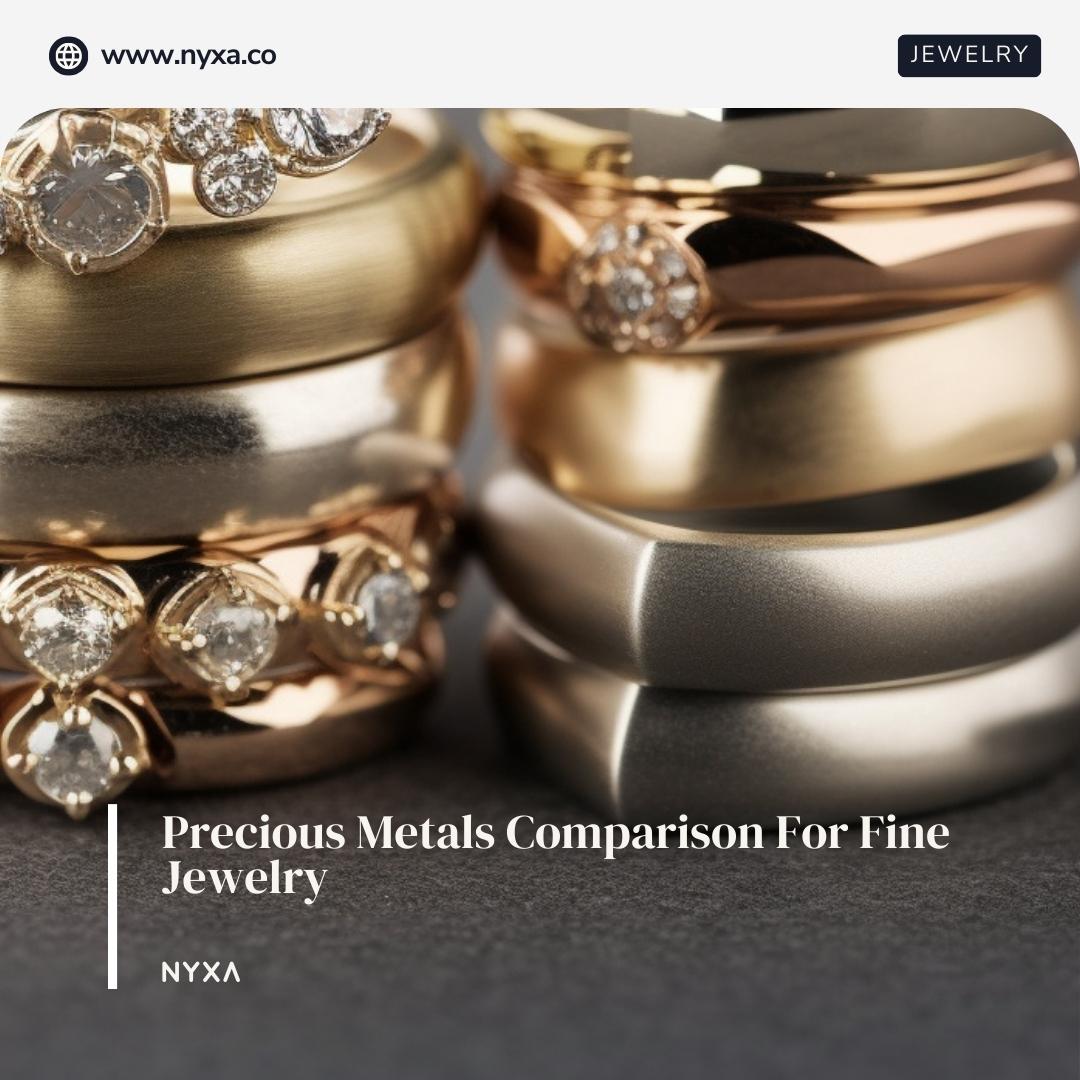
Precious Metals Comparison For Fine Jewelry
Share
When it comes to choosing the perfect metal for your treasured jewelry, it's not just about aesthetics; it's about understanding the unique qualities each precious metal possesses. As a jewelry enthusiast, I often find that clients are enchanted by the design and style of a piece but may stumble when asked about their preferred precious metal. To shed light on this important decision, I'm here to guide you through the world of precious metals, helping you make an informed choice that aligns with your preferences, lifestyle, and budget.
GOLD COLORS AND KARATS
Gold, the eternal symbol of luxury and beauty, has been adorning jewelry for centuries. But did you know that there's more to gold than its radiant color? Gold purity is measured in karats, with 24 karats being 100% pure gold. Here's a breakdown:
- 24 karat (24K): This is pure gold in its softest form.
- 18 karat (18K): Comprising 75% gold, it's renowned for its vibrant, yellow hue.
- 14 karat (14K): With 58.5% gold content, it's a balance between durability and color.
Yellow gold, the classic choice, is typically alloyed with copper, silver, and zinc.
ROSE GOLD
For those who seek a touch of romance, rose gold is an enchanting option. Its warm, blush tone is achieved by mixing gold with a higher proportion of copper than silver and zinc. The karat rating determines the intensity of the rose color:
- Higher karats: Appear more peach due to increased gold content.
- Lower karats: Tend to be pinker due to a higher copper presence.
WHITE GOLD
White gold offers the elegance of platinum at a more accessible price point, but choosing the right alloy can be complex. Consider the following factors:
NICKEL WHITE GOLD
Traditionally, nickel was used to bleach gold, resulting in white gold. However, it still retains a slight yellowish tint. Most commercial white gold jewelry undergoes rhodium plating to achieve a bright white appearance. This plating requires periodic maintenance and may trigger nickel allergies.
PALLADIUM WHITE GOLD
Palladium white gold alloys have a warm grayish-white tone. Palladium, silver, and copper are used to remove the yellow tint, making them hypoallergenic. Unlike nickel white gold, they don't require rhodium plating, making them low-maintenance. Many appreciate their natural appearance.
PALLADIUM
Palladium, a member of the Platinum Metals Group (PMG), is a rare, grayish-white metal. It's typically used in an alloy that's 95% pure palladium, mixed with ruthenium. Palladium is renowned for its malleability, durability, and resistance to scratches. It's naturally white, hypoallergenic, and lightweight, making it an ideal choice for comfortable wedding bands. However, it's worth noting that palladium's price has surged in recent years, rivaling platinum.
PLATINUM
Platinum, the epitome of luxury, has adorned fine jewelry for centuries. Naturally grayish-white and hypoallergenic, platinum requires no rhodium plating. It boasts exceptional malleability, perfect for intricate designs and secure stone settings. Due to its density, platinum is ideal for holding large diamonds securely. Over time, platinum develops a rich patina, enhancing its allure. While it's the priciest option, its rarity, purity, and longevity make it a timeless investment.
STERLING SILVER
Sterling silver is a classic choice for those seeking timeless elegance without breaking the bank. It's an alloy composed of 92.5% silver and 7.5% other metals, typically copper. Here's why you might consider sterling silver:
- Affordability: Sterling silver offers a beautiful, silver sheen at a fraction of the cost of other precious metals.
- Versatility: It complements a wide range of gemstones and jewelry designs.
- Tarnish Resistance: Sterling silver is less prone to tarnish compared to pure silver.
Some popular sterling silver pieces in NYXA's collection include the Bastian Sterling Silver Dome Ring, Ourea Sterling Silver Hoops, and the Castro Cuff Sterling Silver Bracelet.
In conclusion, selecting the right precious metal for your fine jewelry involves considering color preferences, lifestyle, and budget. Each metal has its unique charm and characteristics, ensuring there's a perfect choice for every individual. To explore these options in more detail, take a deeper dive into our white metals comparison.
FAQs
What is the most hypoallergenic white metal for jewelry?
Palladium white gold is an excellent hypoallergenic choice due to its lack of nickel.
Why does rhodium plating wear off in white gold jewelry?
Rhodium plating wears off due to natural wear and the wearer's body chemistry.
What is the significance of karats in gold jewelry?
Karats indicate the purity of gold, with higher karats containing more gold content.
How can I maintain the shine of my platinum jewelry?
Platinum develops a patina over time but can be re-polished or re-textured by a jeweler to restore its shine.
Why has the price of palladium risen in recent years?
Palladium's price increase is due to its rarity and growing demand in various industries.
Is sterling silver a durable option for daily wear jewelry?
Sterling silver is durable and suitable for daily wear, but it may require occasional cleaning to maintain its shine.
Now that you're equipped with knowledge about precious metals, you can confidently choose the perfect one for your cherished jewelry pieces. Access a world of elegance and beauty by making an informed decision.
Access Now: Explore Our Jewelry Collection
